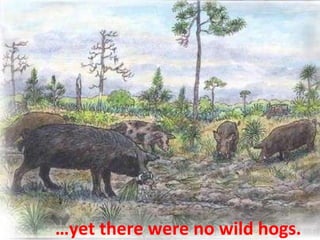The Hasinai Caddo (pt. 3)
- 1. … yet there were no wild hogs.
- 2. The Caddo also traded for various resources across North America.
- 3. From 1300-1700A.D., Caddo Culture declined.
- 4. Soon Europeans began exploring.
- 5. Spain and France both colonized and explored North America.
- 8. Both introduced a new religion…
- 9. and many unwelcomed germs and diseases!
- 10. Spain built Missions in east Texas…
- 11. and the King’s ±áľ±˛µłó·É˛ą˛â…
- 12. while France established trading posts.
- 13. Some Europeans believed all Native Americans were savages, but this was untrue! Many tribes like the Caddo were friendly and peaceful.
- 14. After settlers claimed their lands, the Caddo negotiated for peace.
- 15. Caddo culture and history still thrives today!!!
- 16. Thanks to dedicated ±č°ů´Ç´Ú±đ˛ő˛őľ±´Ç˛Ô˛ą±ô˛ő…
- 17. like archaeologists and historians.
- 18. Looting is the greatest threat to archaeology !
- 19. It is also against the law!!!
- 20. The staff at Caddo Mounds State Historic Site are deeply committed to preserving and sharing Caddo culture and history.
- 21. The end.
Editor's Notes
- Although the wild hog population in Texas is tremendous, there were none in the woods of east Texas for the Caddo to hunt. Hogs and pigs were brought to North America by the Spanish!
- The Caddo participated in vast trading networks that extended into Central Texas, the Great Lakes regions and the Gulf of Mexico. They traded their goods and food for highly prized materials such as turquoise and obsidian from the Southwest, flint from the Panhandle region, shell from the Gulf Coast and copper from the northeast.
- Caddo culture reached its peak and began to decline in a period that archaeologists call the Late Caddo (1300-1700). Ceremonial centers became smaller, trading became very limited and the social hierarchy functioned at a local level without the same material wealth and ceremonialism as before. The quality of Caddo pottery also declined.
- Near the mid-16 th century, Europeans began exploring the southeastern parts of North America (Hernando De Soto 1539-1543).
- Much of what we know today about Caddo culture and history comes from early journals by Spanish explorers and French traders. The Caddo were caught in the middle of Spain’s and France’s struggle to control North America. The Spanish explored and searched for gold while the French sought wealth through trading. Archaeologist call this time period the Historic Caddo (1700-1850).
- The Spaniards brought horses. Horses were not in North America until the Spanish introduced them!
- They brought new types of weapons.
- They brought a new religion.
- … and unfortunately, Europeans introduced foreign germs and diseases. Archaeologist and Historians believe diseases destroyed over 95% of Native American populations throughout the Americas.
- Spain’s first mission in east Texas was Mission San Francisco de los Tejas; established in 1690, 3 miles west of Caddo Mounds.
- Mission Tejas is also built along the El Camino Real de los Tejas, better known as the King’s highway. This historic road has existed for more than 300 years. The El Camino Real begins in Louisiana and runs all the way into Mexico. (Highway 6 in Louisiana and Highway 21 in Texas)
- Although the Caddo did occasionally war with neighboring tribes, they were actually peaceful towards Europeans. The idea that they were bloodthirsty, uncivilized cannibals is simply untrue.
- After suffering from lethal epidemics and violent clashes with Europeans over their home lands, the remaining Caddo peacefully negotiated and signed a treaty with the U.S. government in 1835. The Caddo eventually relocated to Indian Territory, present day Binger, Oklahoma.
- Today, there are about 2,000 Caddo who are committed to retaining their rich cultural heritage. They annually participate in Caddo Culture Day at Caddo Mounds State Historic Site every October. Tribal elders provide insightful perspectives that help keep ancient Caddoan rites and traditions alive.
- Today we learn about Caddo culture and history from the work of dedicated professionals such as Archaeologists and Historians. Archaeology and History are both scientific methods used to understand our past. Archaeology deals with the recovery and analysis of environmental data while History involves acquiring knowledge through investigating past events and perspectives.
- Good archaeology work is precise, tedious, methodical and deliberate. Ultimately, archaeologists seek to better define who we are and understand why we behave as we do. Thus, if we want to understand ourselves and our world today, we must try to understand our past.
- The greatest threat to preserving our past is looting. Looters only destroy historical and archaeological sites in search of artifacts. Looting is unethical, immoral, selfish and against the law!!! Agencies such as the Texas Historical Commission and Native American Graves and Repatriation Act (NAGPRA) work to effectively end these unlawful practices.
- The staff at Caddo Mounds State Historic Site are deeply committed to ensuring that the unique history and culture of the Caddo people lives on…
- The End.





















